| View previous topic :: View next topic |
| Author |
Message |
John S. White
Site Admin

Joined: 04 Sep 2006
Posts: 1298
Location: Stewartstown, Pennsylvania, USA



|
 Posted: Nov 08, 2017 14:47 Post subject: Re: Rarest quartz twins with inclined axes C Posted: Nov 08, 2017 14:47 Post subject: Re: Rarest quartz twins with inclined axes C |
|
|
I came into this discussion a little late so please forgive me if this is something that has already been disclosed. What confuses me is that I see no mention of the goniometry that enabled the writer to determine the angles between the various crystals. My inclination when I see satellite crystals growing upon a large crystal in many different angles is to believe that if one of them is at an angle very close to a recognized twin angle, that is merely an accident and not a twin. So first, my question is how were these angles measured?
_________________
John S. White
aka Rondinaire |
|
| Back to top |
|
 |
marco campos-venuti

Joined: 09 Apr 2014
Posts: 234
Location: Sevilla



|
 Posted: Nov 08, 2017 15:33 Post subject: Re: Rarest quartz twins with inclined axes C Posted: Nov 08, 2017 15:33 Post subject: Re: Rarest quartz twins with inclined axes C |
|
|
| John, I think that when two crystals grow over a matrix, many different forces interact. In contrary, when a second crystal grows over a face of a first crystal, its orientation depends mainly by atomic lattice. The same happens in phenocrystals floating in magma.
|
|
| Back to top |
|
 |
John S. White
Site Admin

Joined: 04 Sep 2006
Posts: 1298
Location: Stewartstown, Pennsylvania, USA



|
 Posted: Nov 08, 2017 19:05 Post subject: Re: Rarest quartz twins with inclined axes C Posted: Nov 08, 2017 19:05 Post subject: Re: Rarest quartz twins with inclined axes C |
|
|
Not an answer to my question.,
_________________
John S. White
aka Rondinaire |
|
| Back to top |
|
 |
marco campos-venuti

Joined: 09 Apr 2014
Posts: 234
Location: Sevilla



|
 Posted: Nov 08, 2017 19:25 Post subject: Re: Rarest quartz twins with inclined axes C Posted: Nov 08, 2017 19:25 Post subject: Re: Rarest quartz twins with inclined axes C |
|
|
| I mean that often it can be a twin instead of an accident.
|
|
| Back to top |
|
 |
Pete Richards
Site Admin
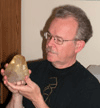
Joined: 29 Dec 2008
Posts: 846
Location: Northeast Ohio



|
 Posted: Nov 08, 2017 19:58 Post subject: Re: Rarest quartz twins with inclined axes C Posted: Nov 08, 2017 19:58 Post subject: Re: Rarest quartz twins with inclined axes C |
|
|
| marco campos-venuti wrote: | | I mean that often can be a twin instead than an accident. |
Marco, please tell us how you decide that a relationship between two individual crystals constitutes twinning - what is the definition of a twin, in your view? How does it differ from auto-epitaxy?
_________________
Collecting and studying crystals with interesting habits, twinning, and epitaxy |
|
| Back to top |
|
 |
marco campos-venuti

Joined: 09 Apr 2014
Posts: 234
Location: Sevilla



|
 Posted: Nov 08, 2017 20:27 Post subject: Re: Rarest quartz twins with inclined axes C Posted: Nov 08, 2017 20:27 Post subject: Re: Rarest quartz twins with inclined axes C |
|
|
I think auto-epitaxy is a synonym of twinning. Epitaxy is between two different minerals.
If a secondary xl (or a epitaxial film) grows over a main xl, its atoms will continue the lattice of the first. And they orientate following some laws. This is a twin.
The diagrams of reef look like epitaxy when he draws a small xl over a big one, but when he draws two xls of the same size they look more like twins. Isn't it?
|
|
| Back to top |
|
 |
Reef
Joined: 13 Dec 2016
Posts: 36


|
 Posted: Nov 09, 2017 11:25 Post subject: Re: Rarest quartz twins with inclined axes C Posted: Nov 09, 2017 11:25 Post subject: Re: Rarest quartz twins with inclined axes C |
|
|
| John S. White wrote: | | ... So first, my question is how were these angles measured? |
If there is a parallelism of faces and edges, as in diagrams, then there is no doubt. It will be a twin. It remains only to make sure of the parallelism. Measuring the angle on a goniometer is sometimes more difficult than seeing the parallelism in a microscope. I additionally confirmed my samples on a goniometer.
to Pete Richards:
Maybe this quote from Wikipedia will clarify: "Some authors[18] consider that overgrowths of a second generation of the same mineral species should also be considered as epitaxy, and this is common terminology for semiconductor scientists who induce epitaxic growth of a film with a different doping level on a semiconductor substrate of the same material. For naturally produced minerals, however, the International Mineralogical Association (IMA) definition requires that the two minerals be of different species.[19]"
When homoepitaxy occurs, the crystal itself grows or the next generation occurs with the same orientation of the crystal lattice.
Twins are a regular, nonparallel fusion of crystalline individuals of a single mineral.
The formation of twins is determined by the properties of the lattice of the crystal, and occurs according to strictly defined laws.
|
|
| Back to top |
|
 |
Frompard
Joined: 17 Oct 2017
Posts: 1
Location: Gloucester City, NJ 08030


|
 Posted: Nov 14, 2017 07:57 Post subject: Re: Rarest quartz twins with inclined axes C Posted: Nov 14, 2017 07:57 Post subject: Re: Rarest quartz twins with inclined axes C |
|
|
| Thanks for your tips dear friend, like when getting a hand of help here!
|
|
| Back to top |
|
 |
Reef
Joined: 13 Dec 2016
Posts: 36


|
 Posted: Nov 21, 2017 11:20 Post subject: Re: Rarest quartz twins with inclined axes C Posted: Nov 21, 2017 11:20 Post subject: Re: Rarest quartz twins with inclined axes C |
|
|
Another law of twinning quartz under the working title "Ural". Theoretically, this law has already been predicted. Samples that confirm this law have not been found so far. It is an analogue of a twin by the law of Disentis, only with a different angle of rotation.
Description of this law:
The face of the rhombohedron (10-11) of one individual is parallel to the face of the prism of the other. One of them is a contact one. The angle of rotation relative to the normal to the prism m is 61.93 °. Vectors of the face zone [1-22] and [2-1-2] are parallel (r1b2q3 || r3q2b1 by C. Frondel). Most laws require instrumental confirmation. And the samples according to the laws of Disentis and Ural are even visually easy to diagnose (provided good visibility of parallel faces).
| Description: |
Ural law twin
Color lines show parallel edges (zone vectors). Crosses are parallel faces.
Variant 1 |
|
| Viewed: |
29182 Time(s) |
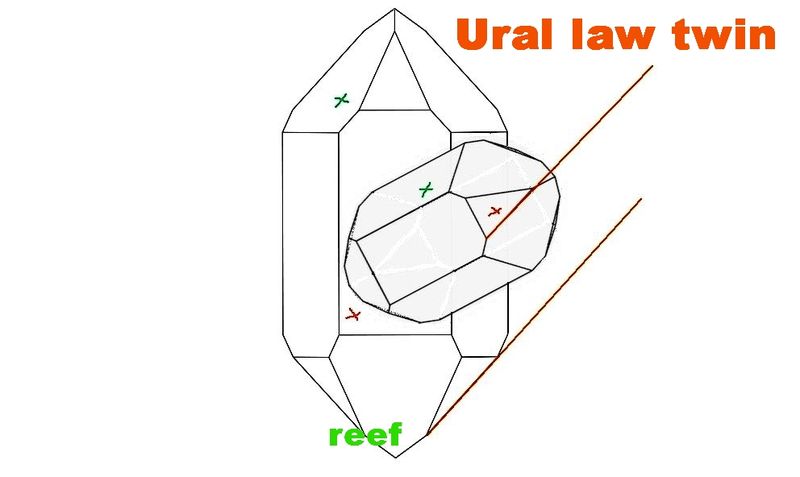
|
| Description: |
Ural law twin
Color lines show parallel edges (zone vectors). Crosses are parallel faces.
Variant 2 |
|
| Viewed: |
29184 Time(s) |
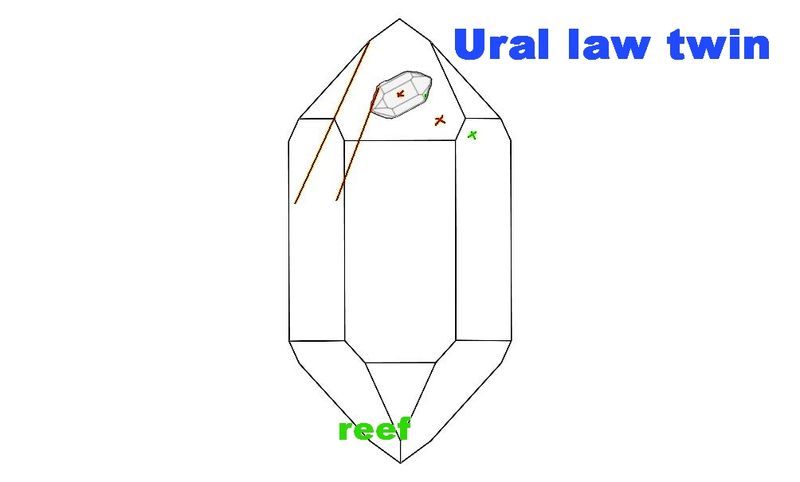
|
| Mineral: | Quartz |
| Locality: | | Orenburgskaya Oblast, Southern Urals, Urals Region, Russia |  |
|
| Dimensions: | 11x6mm |
| Description: |
Ural law twin
1 (1) and 1 (4) - one sample from different angles |
|
| Viewed: |
29133 Time(s) |
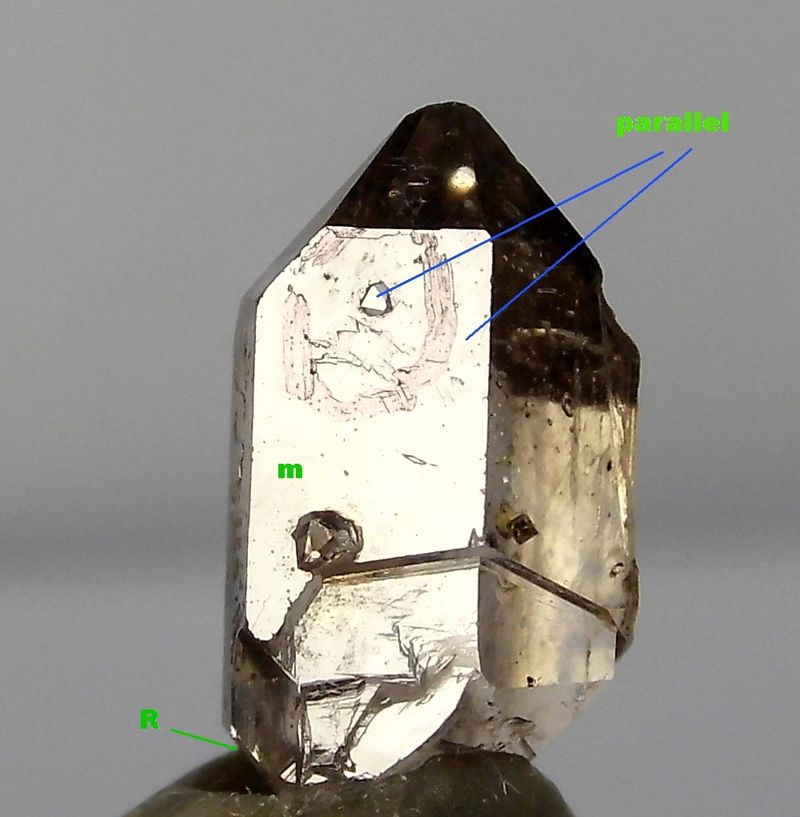
|
| Mineral: | Quartz |
| Locality: | | Orenburgskaya Oblast, Southern Urals, Urals Region, Russia |  |
|
| Dimensions: | 11x6mm |
| Description: |
Ural law twin
1 (1) and 1 (4) - one sample from different angles |
|
| Viewed: |
29183 Time(s) |
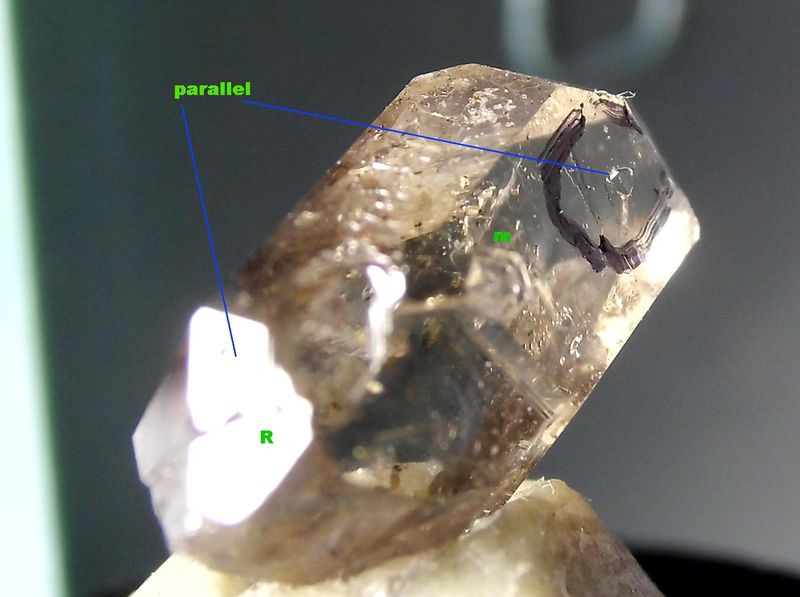
|
| Mineral: | Quartz |
| Locality: | | Orenburgskaya Oblast, Southern Urals, Urals Region, Russia |  |
|
| Dimensions: | 10x6mm |
| Description: |
Ural law twin
3 (2) and 3 (3) - one sample from different angles |
|
| Viewed: |
29102 Time(s) |
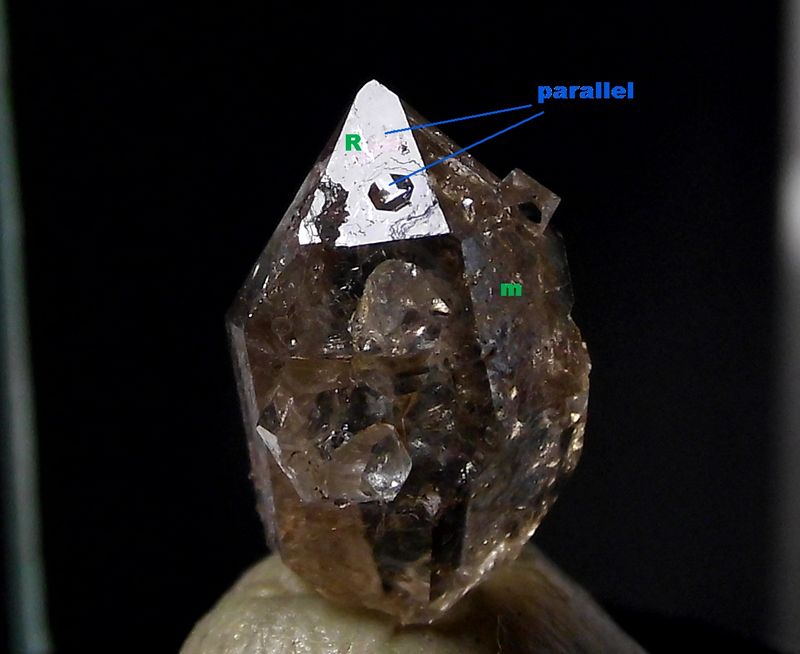
|
| Mineral: | Quartz |
| Locality: | | Orenburgskaya Oblast, Southern Urals, Urals Region, Russia |  |
|
| Dimensions: | 10x6mm |
| Description: |
Ural law twin
3 (2) and 3 (3) - one sample from different angles |
|
| Viewed: |
29152 Time(s) |
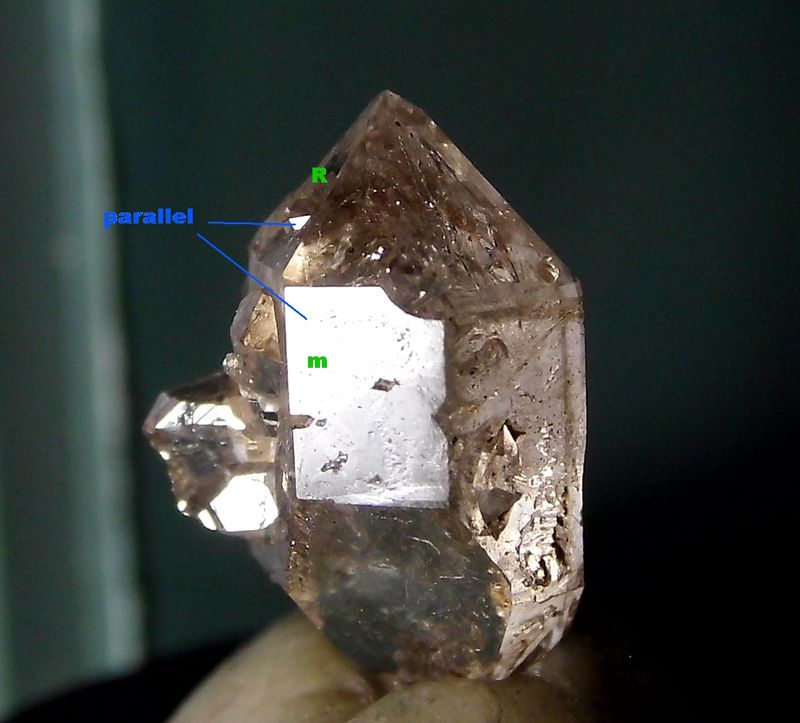
|
|
|
| Back to top |
|
 |
Bob Morgan
Joined: 18 Jan 2018
Posts: 251
Location: Savannah, Georgia



|
 Posted: Nov 09, 2018 17:51 Post subject: Re: Rarest quartz twins with inclined axes C Posted: Nov 09, 2018 17:51 Post subject: Re: Rarest quartz twins with inclined axes C |
|
|
At the risk of adding confusion to this discussion, I prefer to call what Pete calls auto-epitaxy deposition twins. This is where a smaller crystal develops on an already established larger crystal and does so according to the twin law showing the same characteristic morphology of 'v' twins. This is quite common with Japan Law twinning. It is true of quite a lot of Greiserntal Law twins. In both cases there is more rapid growth in the twin notch, rapid widening of the smaller crystal, and markedly less growth in the supplemental angle on the other side of the smaller crystal. If the larger crystal is clear, the twin composition plane shows and is consistent with the twin law.
These depositions can be oriented in either of two directions 1) with the twin angle toward the termination of the larger crystal or 2) with the twin angle toward the base of the larger crystal. There are several instances where a larger crystal hosts separate twins of both orientations.
Now, this leads me to comment on the supposedly Reichenstein Law. There is no rational twin plane or twin axis for such a law. The photo's showing parallel pyramidal faces are therefore just the supplementary angle to the Greiseerntal Law twin that is oriented toward the larger crystal's base. Note too, that Japam Law twins have two sets of parallel pyramidal faces across the supplementary 96 degree angle, and that's not a separate twin law.
|
|
| Back to top |
|
 |
Recovering - Academic
Joined: 24 Apr 2018
Posts: 316


|
 Posted: Nov 09, 2018 18:12 Post subject: Re: Rarest quartz twins with inclined axes C Posted: Nov 09, 2018 18:12 Post subject: Re: Rarest quartz twins with inclined axes C |
|
|
| John S. White wrote: | | It may seem a small point but the proper name for the twin is Japan law twin, not Japanese twin. Japanese twins are properly represented in the attached image. |
REAL JAPAN LAW TWINS
| Description: |
|
| Viewed: |
11241 Time(s) |
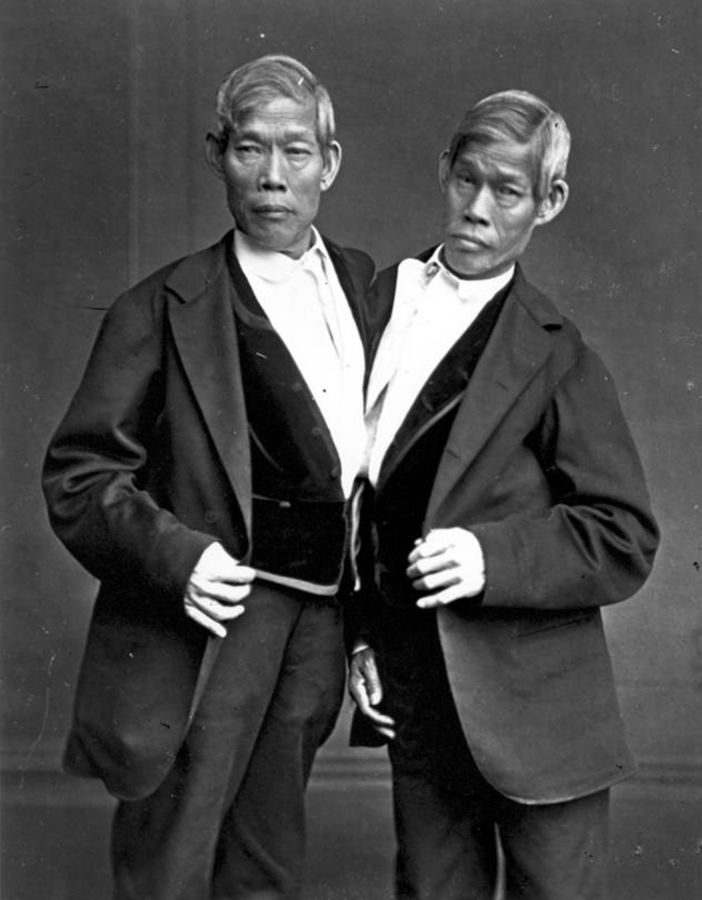
|
_________________
“The further a society drifts from the truth, the more it will hate those that speak it.”
― George Orwell |
|
| Back to top |
|
 |
Recovering - Academic
Joined: 24 Apr 2018
Posts: 316


|
 Posted: Nov 09, 2018 18:16 Post subject: Re: Rarest quartz twins with inclined axes C Posted: Nov 09, 2018 18:16 Post subject: Re: Rarest quartz twins with inclined axes C |
|
|
Interesting!!
_________________
“The further a society drifts from the truth, the more it will hate those that speak it.”
― George Orwell |
|
| Back to top |
|
 |
Recovering - Academic
Joined: 24 Apr 2018
Posts: 316


|
 Posted: Nov 09, 2018 18:17 Post subject: Re: Rarest quartz twins with inclined axes C Posted: Nov 09, 2018 18:17 Post subject: Re: Rarest quartz twins with inclined axes C |
|
|
| Bob Morgan wrote: | At the risk of adding confusion to this discussion, I prefer to call what Pete calls auto-epitaxy deposition twins. This is where a smaller crystal develops on an already established larger crystal and does so according to the twin law showing the same characteristic morphology of 'v' twins. This is quite common with Japan Law twinning. It is true of quite a lot of Greiserntal Law twins. In both cases there is more rapid growth in the twin notch, rapid widening of the smaller crystal, and markedly less growth in the supplemental angle on the other side of the smaller crystal. If the larger crystal is clear, the twin composition plane shows and is consistent with the twin law.
These depositions can be oriented in either of two directions 1) with the twin angle toward the termination of the larger crystal or 2) with the twin angle toward the base of the larger crystal. There are several instances where a larger crystal hosts separate twins of both orientations.
Now, this leads me to comment on the supposedly Reichenstein Law. There is no rational twin plane or twin axis for such a law. The photo's showing parallel pyramidal faces are therefore just the supplementary angle to the Greiseerntal Law twin that is oriented toward the larger crystal's base. Note too, that Japam Law twins have two sets of parallel pyramidal faces across the supplementary 96 degree angle, and that's not a separate twin law. |
Interesting!!!
_________________
“The further a society drifts from the truth, the more it will hate those that speak it.”
― George Orwell |
|
| Back to top |
|
 |
|





